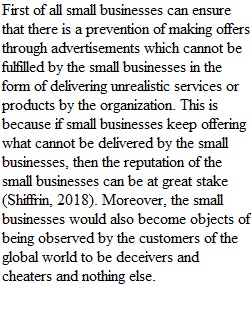


Q Post at least three paragraphs answering the three discussion questions below. Respond to at least two of your classmates following the 2+2 rule described in the Discussion Board Instructions in the Introduction Module. DB5 - ADVERTISING REGULATION CHALLENGES SMALL BUSINESSES U.S. law requires advertising to be “truthful and non-deceptive.” Claims must be based on actual evidence, although puffery, or exaggeration that everyone recognizes as such, is allowed. However, there are no clear boundaries between what constitutes puffery and what represents deceptive advertising. For example, a class-action lawsuit accused Red Bull’s slogan of being deceptive. They claimed the slogan promised some sort of physical enhancement at a minimum, such as improved concentration or reaction speed, and that customers had experienced no such boost. Others would likely disagree with this assessment and maintain that the slogan was an example of puffery that in no way guaranteed physical enhancement in and of itself. Red Bull settled the lawsuit for over $13 million. Small businesses have a hard time complying with advertising law due to lack of legal departments or in-house counsel. This makes them more likely to accidentally cross the legal line between zealous promotion and deception, especially since the Internet makes it easy to develop and publish advertising campaigns. Also, because federal law allows competitors to sue each other for false advertising, some small businesses accuse large companies of using litigation as a weapon to stifle competition. For example, Procter & Gamble sued small toothpaste company Hello Products based on its “99% Natural” labels. Hello Products believed the claim was accurate and in legal compliance, but it changed the labels and settled the lawsuit to avoid paying large legal fees. That same year, Unilever sued a new mayonnaise startup, Hampton Creek, claiming it could not call its product mayonnaise because it does not contain eggs. Considering there were fewer than 10 false advertising court decisions in 1990, but over 60 two decades later, small businesses must continue to expect close scrutiny of their advertising and adjust their strategies accordingly. Discussion Questions 1. How can small businesses ensure they do not engage in misleading advertising and protect themselves from false advertising lawsuits? 2. Why do you believe puffery is allowed in advertising? Why is there often a fine line between puffery and deceptive advertising? 3. Is it fair for large companies such as Unilever to target smaller firms for misleading advertising if the intent of the small firms was not to mislead?
View Related Questions